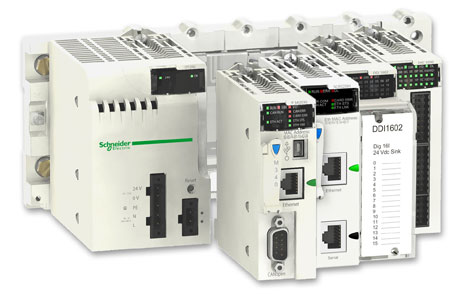
A PROGRAMMABLE LOGIC CONTROLLER (PLC) is an industrial computer control system that continuously monitors the state of input devices and makes decisions based upon a custom program to control the state of output devices.
Almost any production line, machine function, or process can be greatly enhanced using this type of control system. However, the biggest benefit in using a PLC is the ability to change and replicate the operation or process while collecting and communicating vital information.
Another advantage of a PLC system is that it is modular. That is, you can mix and match the types of Input and Output devices to best suit your application.
HISTORY OF PLCS
The first Programmable Logic Controllers were designed and developed by Modicon as a relay re-placer for GM and Landis.
- These controllers eliminated the need for rewiring and adding additional hardware for each new configuration of logic.
- The new system drastically increased the functionality of the controls while reducing the cabinet space that housed the logic.
- The first PLC, model 084, was invented by Dick Morley in 1969
- The first commercial successful PLC, the 184, was introduced in 1973 and was designed by Michael Greenberg.
WHAT IS INSIDE A PLC?
The Central Processing Unit, the CPU, contains an internal program that tells the PLC how to perform the following functions:
- Execute the Control Instructions contained in the User's Programs. This program is stored in "nonvolatile" memory, meaning that the program will not be lost if power is removed
- Communicate with other devices, which can include I/O Devices, Programming Devices, Networks, and even other PLCs.
- Perform Housekeeping activities such as Communications, Internal Diagnostics, etc.
-
PLC ACRONYMS
The following table shows a list of commonly used Acronyms that you see when researching or using your PLC.
ASCII American Standard Code for Information Interchange BCD Binary Coded Decimal CSA Canadian Standards Association DIO Distributed I/O EIA Electronic Industries Association EMI ElectroMagnetic Interference HMI Human Machine Interface IEC International Electrotechnical Commission IEEE Institute of Electrical and Electronic Engineers I/O Input(s) and/or Output(s) ISO International Standards Organization LL Ladder Logic LSB Least Significant Bit MMI Man Machine Interface MODICON Modular Digital Controller MSB Most Significant Bit PID Proportional Integral Derivative (feedback control) RF Radio Frequency RIO Remote I/O RTU Remote Terminal Unit SCADA Supervisory Control And Data Acquisition TCP/IP Transmission Control Protocol / Internet Protocol

A variable-frequency drive (VFD; also termed adjustable-frequency drive, variable speed drive, AC drive, micro drive or inverter drive) is a type of adjustable-speed drive used in electro-mechanical drive systems to control AC motor speed and torque by varying motor input frequency and voltage.[1][2][3][4]
VFDs are used in applications ranging from small appliances to large compressors. About 25% of the world's electrical energy is consumed by electric motors in industrial applications, which can be more efficient when using VFDs in centrifugal load service;[5] however, VFDs' global market penetration for all applications is relatively small.
Over the last four decades, power electronics technology has reduced VFD cost and size and has improved performance through advances in semiconductor switching devices, drive topologies, simulation and control techniques, and control hardware and software.
VFDs are made in a number of different low- and medium-voltage AC-AC and DC-AC topologies

 Get in Touch
Get in Touch 